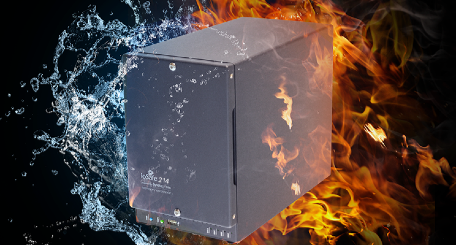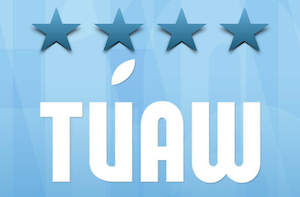ioSafe 214 NAS: Keeping data safe from fire, water, and drive failures

ioSafe has been around for a while, making mass storage devices that can survive fires and floods -- you know, the things that do happen to people and destroy their usual inexpensive backup hard drives. Lately ioSafe has teamed with Synology to add that company's DiskStation Manager (DSM) to a pair of network-attached storage (NAS) products that can withstand catastrophes, and today I'm looking at the ioSafe 214 NAS, a dual-drive disaster-proof solution.
Specifications
Price: US$899.99 (as configured). Pricing of other configurations available here.
Dimensions: 5.9 in (150mm) x 9.06 in (230mm) x 11.5 in (292mm)
Weight: 28 pounds (12.7 kilograms)
Power: 100 to 240V, 50-60Hz single phase, 18.48 W (accessing data); 8.28 W (hibernating)
Interface: Gigabit Ethernet, two USB 3.0 ports, one USB 2.0 port (Wi-Fi can be enabled by using a USB dongle)
Maximum Capacity: 8 TB (two 4 TB HDD), usable 4 TB RAID 1
Capacity As Tested: 916 GB (two 1 TB HDD in RAID 1 configuration)
Fire Protection: Up to 1550°F, 30 minutes per ASTM E-119
Flood Protection: Fully submersed, fresh or salt water, 10 foot depth, 72 hours
Theft Protection: Kensington security slot and optional floor mount with padlock
Drives: Two 3.5" or 2.5" SATA(II), hot-swappable
Design Highlights
The biggest selling point of the ioSafe 214 is the survivability of the NAS in case of a fire. This array is designed to pretty much survive a fire in a business as well as the inundation that you'd expect from firefighters trying to put out that fire. Even if the NAS is damaged, ioSafe provides a Data Recovery Service that pays for shipping, attempting recovery of data, and then spends up to $2500 ($5000 for businesses) per terabyte of data for forensic recovery. After that, they'll send the recovered data back to you on "replacement product." For pro-sumers or businesses, this is hefty insurance for your precious data.
The NAS is heavy -- 28 pounds -- and taking off the front cover of the device with the included tool illustrates why. The interior and the "door" are lined with a thick ceramic material to provide the necessary protection from fire. Inside are two drives; ioSafe notes that they can be either 3.5 or 2.5 inch drives.
Functionality Highlights
The next big feature set of the ioSafe 214 is the Synology DSM implementation. You're not just buying a NAS when you get this box -- instead, you're getting what is essentially a full file server. Synology DSM adds File Station for sharing and managing files, Photo Station (online photo album plus blog), Antivirus Essential Server, Directory Server (LDAP service with access control and authentication for business users), iTunes Server, Surveillance Station (can manage IP cameras to guard your business), Video Station (for browsing and organizing video content), Media Server (to add TV sets and stereos to the network for watching stored media), Cloud Station (file sharing like Dropbox, without the monthly fee), Audio Station (web-based audio app), Download Station (web-based download app), Mail Station (webmail service), Time Backup (backing up ioSafe data with versioning), VPN Server (turns your device into a VPN server). If that's not enough, you can also download other applications from Synology.
I used to be an Apple Consultants Network member and received certification in OS X Server. I wish I had known about Synology DSM and the ioSafe 214 back in those days, because I would have passed on using and supporting OS X Server. Seriously, from taking the ioSafe 214 out of the box to setting up a user for benchmarking took me only about 3 minutes. That user was set up with Mac, Windows, and NFS file services immediately, full FTP and WebDAV access, etc... Synology DSM is set up from a web-based control panel that is both incredibly easy to use and filled with power. Note to Apple: you've already departed the server hardware business, now get out of the server OS biz.
For the purposes of my testing, which is more about using the ioSafe 214 as a fast, network-attached storage device instead of as a full file server, I am going to concentrate on the benchmarks. But I seriously recommend that any small business that is considering setting up a server consider this device with Synology DSM instead of OS X Server. Not only do you get mass storage that is capable of handling the worst disasters that you can imagine, but it also provides all of the services of OS X Server without any of the setup and support hassles.
Benchmarks
For the purposes of testing external drives and RAID arrays, we traditionally use the Intech SpeedTools QuickBench 4.0 app to run multiple cycles of read/write tests. In this case, both the Mac that was running QuickBench (MacBook Pro with Retina display) and the array were connected via Gigabit Ethernet. The MacBook Pro was using an Apple Thunderbolt to Gigabit Ethernet adapter; the ioSafe 214 has built-in Gigabit Ethernet; and the two were connected via a Linksys Gigabit Ethernet router.
To ensure accuracy in testing, I performed a 100-cycle complete test. This subjects the drive to sequential and random read and write tests with file sizes from 4K to 100 MB, then graphically or textually displays that information to show the "sweet spots" for a specific drive or array. For example, if your work involves shuffling around a lot of very large files, you'll probably want a drive that has peak read/write speeds for files around your average file size. Here are the test results, with a comparison to the Drobo 5N NAS that we reviewed recently:
Sequential Read: 54.578 MB/Sec (48.452 MB/Sec for Drobo 5N)
Sequential Write: 47.910 MB/Sec (12.398 MB/Sec for Drobo 5N)
Random Read: 57.856 MB/Sec (51.344 MB/Sec for Drobo 5N)
Random Write: 45.936 MB/Sec (21.866 MB/Sec for Drobo 5N)
Large Read: 110.466 MB/Sec (109.947 MB/Sec for Drobo 5N)
Large Write: 109.567 MB/Sec (71.205 MB/Sec for Drobo 5N)
Extended Read: 107.834 MB/Sec (107.690 MB/Sec for Drobo 5N)
Extended Write: 64.963 MB/Sec (46.833 MB/Sec for Drobo 5N)
Compared to the competing Drobo 5N, the ioSafe 214 was faster at write speeds across the board. Read speeds were slightly faster for smaller file sizes, and almost identical for large and very large files sizes.
Conclusion
For a small business looking for a way to provide shared storage to a group of employees, the ioSafe 214 NAS would be a good solution. Add the fireproof and waterproof design and the amazing Data Recovery Service, and you'd have an excellent small business storage solution. What makes the ioSafe 214 NAS a must-buy for small businesses is the integration of Synology DSM.
I'm also impressed with the pricing, which ranges from $899 for a 214 NAS with two 1 TB drives to $1,999 for the same unit with two 4 TB drives. While that may not seem like a bargain, consider what you'd spend trying to recover data from a hard drive destroyed by a fire or flood. Not only will the ioSafe 214 NAS have a better chance of surviving a catastrophe, but even if it doesn't the company's included Data Recovery Service has a very good chance of making sure at least some of your data is returned to you. A year of DRS is included in the base price of the device, and additional years of coverage are reasonably priced.
But this is more than just a ruggedized NAS -- the ioSafe 214 NAS is a powerful server that can provide all of the capabilities that a small business needs, without the hassle of confusing or complicated setup. If I was still an Apple consultant, I know that I'd be recommending the ioSafe 214 NAS or its larger brother (the ioSafe 1513+ NAS) to my small business clients without hesitation. As a tech reviewer, I can definitely recommend this product.
Rating: 4 stars out of 4 stars possible


